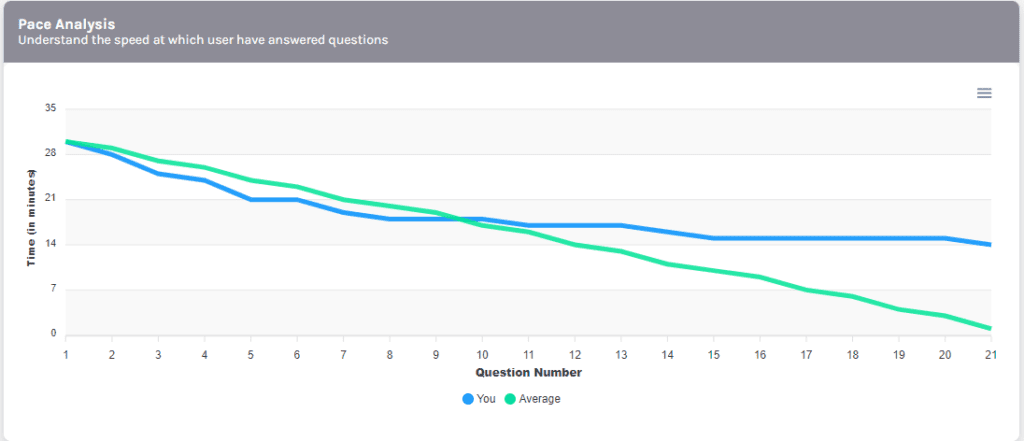Only their final score matters when a student takes a test such as the SAT or ACT. A good score is a strong indicator of academic knowledge. However, students must work on several factors beyond theoretical knowledge to improve test scores. For instance, it is equally important to manage your time effectively and factor it into test-taking strategies and planning.
Simply focusing on academic gaps in a student’s test preparation is insufficient for improving their scores. Moreover, if we compare practice tests to actual tests, the difference in the test-taking environments is substantial, primarily due to the time factor. Many students score well at home but don’t fair equally on the SAT/ACTs.
Many students start slow and rush toward the end, whereas many finish the test early, thus underutilizing valuable exam time. While running towards the end, students make several silly mistakes and tend to fight a question and waste time. A student’s ability to sit through the exam and keep their brain active and supercharged for the entire test duration is challenging to build because students often lose patience and make mistakes.
Improving one’s SAT/ACT score requires more than academic performance; time management is critical in scoring high in such exams.
Identifying students’ time management patterns during a test is essential to test preparation. Correct data and analytics can significantly help students understand their time management skills, and students must know how they react under different time and stress constraints.
Unfortunately, pen-and-paper tests and practices need to capture sufficient data concerning time. In the current age of artificially intelligent systems, there are better methods than keeping a stopwatch to manage your time. A computer-aided test can capture time spent on each question. Later, good data analysis can show the hidden behavioral issues related to time management.
Students should start with a diagnostic test/assessment and take more reviews as they progress. The most basic analysis is of a diagnostic test (also called a mock test). The study of the result helps the student build a suitable test-taking strategy, including a good understanding of academic strengths and weaknesses and time management skills.
1. Time Wastage Analysis
Understanding the cause of any time-based mistakes a student may make during tests is also essential. For example, they may spend too much time on questions about a specific topic but need to convert this into marks. To avoid such a waste of valuable time, an analysis of how the student spends their time & the conversion of the time into marks should be done.

After the analysis, specific helpful recommendations can be given to the students to optimize their test-taking strategies. For example, spending more time on a question or “fighting for the answer” doesn’t result in the correct answer. Fundamentally, students should not spend unnecessary time solving a question and instead move on, especially if the question belongs to one of the student’s weak areas.
2. Pace Analysis
Often, a student will finish the test early but may need more time to review the questions. In other cases, students may always need more time. A pace analysis of the remaining time concerning the number of questions must be done. A pattern will reveal various tendencies of the student and related issues. The student may need to solve questions correctly at the cost of too much time, resulting in a rush toward the end.

3. Accuracy vs Time Analysis
High accuracy and high time quadrant will show the need to learn time-saving tricks and formulas. Similarly, high accuracy but low time quadrant shows mastery in the particular area. The areas of low accuracy and low timing clearly show that the student didn’t bother to solve questions and moved on. The low accuracy and high timing quadrant indicate a tendency to fight with the question and require academic intervention.
4. Streak Analysis
A streak analysis helps the student understand their focus window – in which the brain is supercharged, and most questions are answered correctly. It is essential to identify and maximize a student’s best-performing window, the amount of time it takes during the test for their brain to reach its maximum peak. A student can solve most problems correctly in a continuous streak at this peak. The goal should be to maximize this window and start the line as soon as the test begins.

Once students become aware of their time management issues, it becomes easier to distribute the test time according to their academic strengths and weaknesses.
Time Management is key
Improving one’s SAT/ACT score requires more than academic performance; time management is critical in scoring high in such exams. By capturing the correct data and utilizing a good data analysis tool such as HighScores, it is easy to visualize patterns of time management issues.
Once a student becomes aware, it is easy to take corrective action and continuously measure and monitor. HighScores provides students with several analyses and recommendations about effectively managing time when taking exams such as the SATs or ACTs. This helps them improve their scores in a shorter period.


